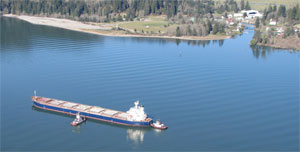Capt. Bradley Warner was guiding the bulk carrier Miyama outbound on the Columbia River when the ship’s steering suddenly stopped responding.
Warner, of the Columbia River Pilots, looked down and saw the tachometer dropping. The captain’s call to the engine room confirmed the ship had lost power, Warner wrote in his report to the Oregon Board of Maritime Pilots.
The engine failure occurred near mile marker 32, a section of the Columbia River with a sandy bottom outside the channel but rocky areas further ahead. With the vessel adrift, Warner thought it was better to ground sooner rather than later.
“When our speed was down to about 8 knots, I ordered the port anchor dropped, which helped us slow further,” he wrote in the report filed shortly after the incident. “The ship very gently slowed and grounded on the Oregon side of the channel.”
The incident occurred at about 1120 on March 4, roughly 30 miles east of Astoria. Investigators determined that the blown engine component caused the power failure and led to the grounding.
“The vessel reportedly lost propulsion while making a turn when a cracked cylinder cover cooling jacket caused a power plant shutdown,” Coast Guard Petty Officer Katelyn Shearer, who is based in Seattle, said in an email. “The crack … resulted in a jacket water leak.”
The vessel had a 23-person crew and 19,500 gallons of fuel aboard at the time of the incident, the Coast Guard said. Nobody was hurt and there were no environmental impacts. The vessel was not damaged.
The 738-foot Miyama had a draft of about 42 feet 11 inches when it left Longview, Wash., at 0735 on the morning of the incident. Warner described the weather as “perfect,” noting 50-degree temperatures and light winds.
The vessel was on a course of 320 degrees near the centerline of the river when the power cut off.
“The ship had come to 319 degrees despite a lot of rudder, at which point the helmsman said the ship would no longer steer,” the report said.
No alarms sounded, but the tachometer’s steady drop indicated engine trouble. The ship’s hull ran aground in about 37 feet of water while the stern was still afloat, the report said.
Warner alerted the pilots association and Coast Guard watch standers, who sent an MH-60 Jayhawk helicopter from Astoria to assess the incident from the air. Meanwhile, two tugboats that happened to be operating nearby also assisted the ship.
Warner, who was relieved by another pilot at 1320, declined to be interviewed for this story. However, the Columbia River Pilots agreed to share his incident report.
The two tugboats initially tried to pull the vessel free from the riverbed during high tide. The first attempt at about 1330 was not successful. The vessel naturally refloated with the tide about 10 minutes later, Shearer said.
After the vessel was freed, it anchored along the edge of the channel, allowing the crew to perform temporary repairs. Shearer said Miyama’s cylinder cover was replaced, restoring power to the ship. The vessel sailed upriver toward Kalama, Wash., for an inspection at about 1640.
The Marshall Islands-flagged Miyama was carrying a load of grain when the grounding occurred. Its point of origin and destination were not available.
Ownership information for the ship, which was built in 2005, could not be confirmed. Southport Agencies, the vessel manager’s local agent in Kalama, declined to comment.

